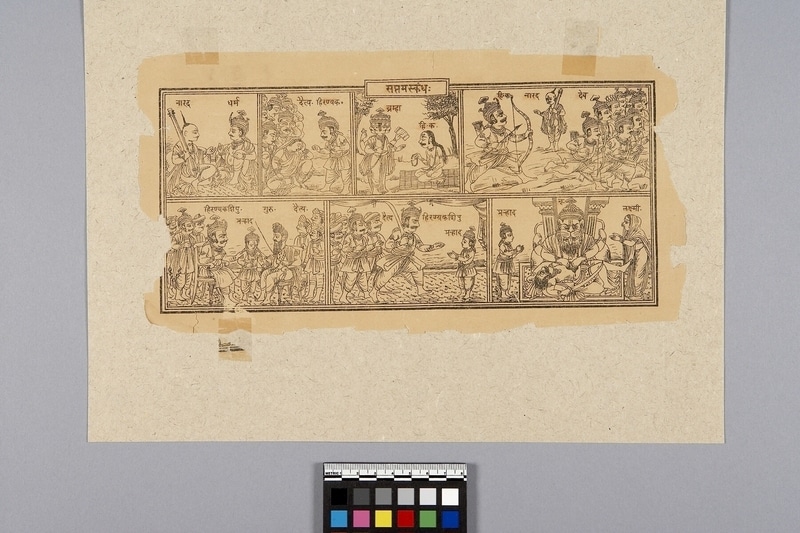Print Item Number: Eg293 from the MOA: University of British Columbia

Description
Rectangular lithograph of seven black line-drawn scenes, fitted together into two horizontal rows separated by lines; on yellowed paper matted on a coarse, fibrous, yellow-brown piece of paper. The print depicts a dramatic episode of patricide and devotion between Demon Kinf Hiranyakashyap, son Prahlad and the God Vishnu and draws from the Hindu text Bhagavata Purana (800-1000 CE). Top row, left to right: two males face each other, one with a long-necked stringed instrument; a standing male with a moustache faces mourning people; a four-headed male stands beside a fasting male kneeling on a mat; a male carrying a bow, arrows and quiver is on the left, a group of running male archers are on the right, and a male with a long-necked, stringed instrument stands at the upper centre. Base row, left to right: two males, with three males behind each of them, are seated facing each other and holding a boy standing between them; a male carrying a saber strides towards the same boy, with a crowd of males at the left; a lion seated on a throne is tearing out the entrails of a male splayed across its lap. There are captions in script for each scene.
History Of Use
Indian popular religious prints have been published for nearly a century, first by German presses, later by Indian ones. This print is one of the earliest Indian lithographs.The Bhagavata Purana is one of Hinduism's eighteen great Puranas (Mahapuranas); it consists of twelve books, totalling 335 chapters and 18,000 verses.
Cultural Context
popular religious art
Item History
- Made in India between 1850 and 1900
- Collected between 1974 and 1982
- Owned by Stephen Inglis before January 1983
- Received from Stephen Inglis (Donor) during January 1983
What
- Name
- Identification Number
- Eg293
- Type of Item
- Overall
- height 29.3 cm, width 36.8 cm
Who
- Culture
- South India
- Previous Owner
- Stephen Inglis
- Received from
- Stephen Inglis (Donor)
Where
- Holding Institution
- MOA: University of British Columbia
- Made in
- India
When
- Creation Date
- between 1850 and 1900
- Collection Date
- between 1974 and 1982
- Ownership Date
- before January 1983
- Acquisition Date
- during January 1983
Other
- Item Classes
- works on paper
- Condition
- fair
- Accession Number
- 0857/0148